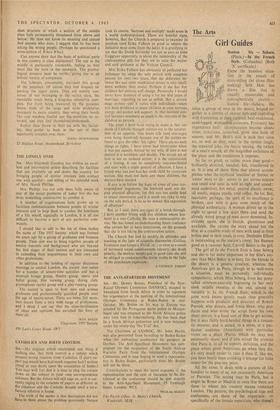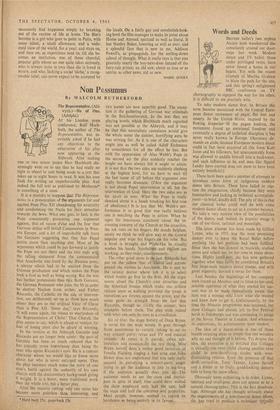The Arts
Girl Guides
Station Six — Sahara.
(Plaza.)—In the French Style. (Columbia) (Both 'X' certificate.) FROM the banalest situa- tion in the annals of story-telling (let alone film- making) Seth Holt has drawn a film that is visually memorable and atmospherically electric— Station Six—Sahara. He takes a group of men in the desert, heaped to- gether in a jumble of shared huts and exploding with frustration at their isolated, heat-maddened, sand-logged, womanlegt existence. Proximity has engendered hate: idiosyncrasies become obses- sions; irritations, scratched, grow into boils of venom; and Mr. Holt's skill is such that soon we, as well as they, react to the violent laugh, the repeated joke, the hectic teasing, the twitch of a man's mouth, all the magnified awfulness of the place and the conditions it imposes.
So far so good; or rather more than good— brilliantly directed, handled, felt, transferred to us. It is one of those films that almost accom- plishes what the mythical `smellies' or 'feelies' or `eaties' were to do : seems to put across texture and smell and taste as well as sight and sound: sand underfoot, hot metal, neutral plastic, sweat, oil smells, engine smells, cold coffee, the lot. But, inevitably perhaps, the spell of its excellence is broken, and with it goes even much of the physical authenticity. A woman drives up in the night to spend a few days there and send the already weird group of men more demented. In- evitably again, she is blonde, glamorous and available. She carries the story ahead but the film, as a credible study of men with sand in their brains and in their souls, is over. Denholm Elliott is outstanding as the station's creep; Ian Bannen good as a raucous Scot; Carroll Baker is the girl.
The girl of In the French Style is Jean Seberg and she is far more important to her film's suc- cess than Miss Baker is to hers; for the blonde in the desert is a generic creature, whereas the American girl in Paris, though in as well-worn a situation, must be personally, individually sympathetic; which Miss Seberg, from her pony- tailed nineteen-year-old beginning to her very sleek middle twenties at the end, almost in- variably is. In the French Style, which is the joint work (more jointly made than generally happens with producer and director) of Robert Parrish, who directs, and Irwin Shaw, who pro- duces and who wrote the script from his own short stories, is a hard sort of film to get across; for it says fairly hard-headed things in a roman- tic manner, and is aimed, in a sense, at a par- ticular audience (American) with particular views on a place (Paris), which we may not necessarily share; and if you accept the premise that Paris is, in all its aspects, delicious, and the place where good Americans go when they die, it's very much easier to take it than if, like me, you have busily been avoiding it (except for train stops) for the past ten years.
All the same, it deals with a pattern of life familiar to many of us, not necessarily American or Parisian. The setting may be Paris, but it might be Rome or Madrid or even (for there are those to whom this country means romance) London. The pattern, the psychological tugs and confusions, _are those of the expatriate: or specifically of the female expatriate, who doesn't
necessarily find happiness simply by breaking out of the routine of life at home. The film's heroine is a girl who goes to paint in Paris, with some talent, a small allowance, and a wide- eyed view of the world, for a year; and stays on, and then on, as expatriates tend to, till she be- comes an institution, one of those cheerful, popular girls whom no one quite takes seriously, who is always more in love than she is loved in return, and who, lacking a social 'niche,' a recog- nisable label, can never expect to be accepted by the locals. On a fairly gay and novelettish-look- ing level the film manages to make its point about Home and Abroad, spiritual as well as literal. It has Stanley Baker, lowering as well as ever, and a splendid face that is new to me, Addison Powell's, as propaganda for the settling-down school of thought. What it really says is that you generally marry the boy-next-door instead of the fairy-tale prince; an old saw, about as true or as untrue as other saws, old or new.
ISABEL QUIGLY











































 Previous page
Previous page